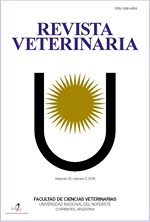Population dynamics of oribatid mites in an endemic zone of sheep cestodosis in Argentina
DOI:
https://doi.org/10.30972/vet.1821904Palavras-chave:
sheep, oribatid mites, population dynamics, intermediate hosts, Anoplocephalidae, Argentina.Resumo
The dynamics in the occurrence of mites intermediate hosts of anoplocephalid cestodes causing mortalities in lambs, was studied in the southwest of Buenos Aires Province (Argentina). Three farms that breed Corriedale and Lincoln sheep, at Puan District, Buenos Aires Province, were visited monthly
(from June to January) to take soil samples from 0 to 6 cm depth. A total of 22 oribatid species
were found. Oribatid males, which are most susceptible to infection with larval stages
of anoplocephalids, were dominant by the end of spring. Zygoribatula lata was the most frequent
and abundant species, representing 70-90% of oribatids found. Further understanding
of the dynamics of oribatid populations in sheep breeding farms, as well as prophylaxis and
treatment alternatives are discussed.
Downloads
Downloads
Publicado
Como Citar
Edição
Seção
Licença
Copyright (c) 2007 G. Denegri, P. Martinez

Este trabalho está licenciado sob uma licença Creative Commons Attribution-NonCommercial 4.0 International License.
Política de acceso abierto
Esta revista proporciona un acceso abierto inmediato a su contenido, basado en el principio de que ofrecer al público un acceso libre a las investigaciones ayuda a un mayor intercambio global de conocimiento. La publicación por parte de terceros será autorizada por Revista Veterinaria toda vez que se la reconozca debidamente y en forma explícita como lugar de publicación del original.
Esta obra está bajo una licencia de Creative Commons Reconocimiento-NoComercial 4.0 Internacional (CC BY-NC 4.0)










.jpg)
.jpg)



